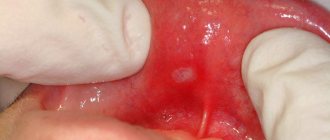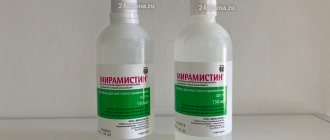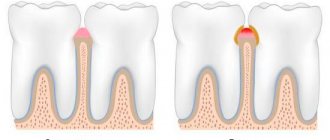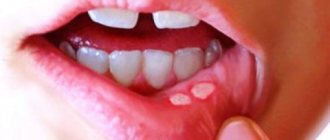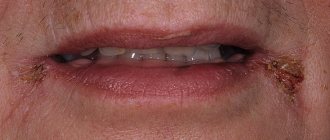Content:
- How do they manifest themselves?
- Where do they come from?
- Consequence of dental diseases
- Aphthae of traumatic nature
- Result of common diseases
- How to cure
Defects of the mucous membranes of the oral cavity are not uncommon.
Many people encounter them. They can occur due to infectious and viral diseases, mechanical damage to tissues. Most often, dentists encounter white sores on the gums. These are painful areas that prevent the patient from enjoying life. They make eating problematic and do not allow for high-quality hygiene measures. Any touch to the affected area provokes acute pain.
It is important not to ignore the presence of white patches on the gums. If they appear, you should contact your dentist. The doctor will determine the cause of the disease and tell you how to eliminate it.
Causes
The exact cause of the origin of this disease is still in question. Doctors are inclined to several probable versions: an allergic reaction, a viral infection, streptococci and staphylococci, immunodeficiencies and genetic abnormalities. The possibility of the formation of CRAS due to disruption of the digestive tract, liver, and nervous system (which may be due to regular stressful situations), as well as due to hazardous production and the environmental situation in the area of residence, cannot be ruled out.
In allergy sufferers, frequent manifestations of this type of stomatitis are accompanied by migraines, asthma, skin rashes and itching. Patients with chronic colitis, gastritis and helminthic infestations may suffer from recurrent aphthous stomatitis due to the large amount of toxins in the blood.
In any case, a relapse of the disease can be triggered by a weakening of the body’s defenses and a malfunction of the immune system. Prerequisites for this may be previously suffered severe forms of influenza, tonsillitis, chronic intestinal diseases, severe allergic reactions to flowering, food products, prosthetic materials, fillings and much more.
Where do they come from?
Conventionally, all provoking factors can be divided into the following groups:
- mechanical or thermal damage to tissues;
- dental diseases;
- systemic pathologies.
In other words, the problem may be much more serious than it seems at first glance.
Consequence of dental diseases
Among the diseases of the oral cavity that cause the appearance of painful white spots are:
- Aphthous stomatitis. Has a relapsing course. A person develops painful aphthae. They can be located on the cheeks, tongue, palate, lips. They always hurt a lot. Heal within 7-10 days. If such an aphtha is damaged by carelessness, the regeneration processes will proceed very slowly and after the end of regeneration, a non-absorbable scar will remain. Until now, scientists have not established why aphthous structures appear. Most researchers believe that reduced immunity is to blame.
- Herpetic stomatitis. Caused by the herpes virus. A huge number of small white erosions appear in the patient’s mouth. Women over the age of thirty are prone to the disease. Aphthae occur on the tongue and on the surface of the floor of the mouth. They do not have clear boundaries. “They drag on” for one to a week and a half. In addition to ulcers, this form of stomatitis causes increased body temperature, enlarged subcervical lymph nodes, and general weakness.
- Necrotizing periadenitis. Another name for this pathology is Setton's aphthae. The disease is difficult to correct. It often takes several years to treat it. First, compactions appear under the mucous membrane. Soon, instead of them, ulcers with protruding edges form. They can be strewn with the surface of the cheeks, tongue, lips. Setton's aphthae are always very painful. They interfere with normal conversation and eating.
- Vincent's ulcerative necrotic stomatitis. Infectious lesion. It is caused by associations of fusobacteria and spirochetes. Painful areas form in the patient's mouth. The condition is aggravated by muscle pain and headaches. To eliminate tumors in the mouth, doctors carry out local etiotropic therapy, use antibiotics and antiprotozoal drugs. It has been noticed that Vincent's disease is more often encountered by men over the age of thirty with reduced immunity and vitamin deficiency.
Necrotizing recurrent periadenitis
Necrotizing recurrent periadenitis (periadenitis mucosa necrotica recurrens), or periadenitis aphthae, recurrent aphthous cicatricial stomatitis (stomatitis aphthosa recurrens cicatricans) or Setton's aphthae. This disease is considered a more severe form of chronic recurrent aphthous stomatitis. Lesions, single or multiple, begin as small, painful submucosal nodules. Over the course of several days, they enlarge, the mucous membrane over them becomes hyperemic, then necrotic. A deep, sharply painful ulcer with raised, compacted edges is formed. Swelling and hyperemia around the ulcer are pronounced. There may be an increase in temperature and a deterioration in general condition. The ulcer heals in 3-12 weeks with the formation of a scar. The disease lasts for years, multiple scars form on the oral mucosa.
The prognosis for chronic recurrent aphthous stomatitis is favorable, but the disease is difficult to treat.
Etiology. The cause of the development of chronic recurrent aphthous stomatitis has not yet been established. Many researchers have noted the connection of this disease with other diseases - the gastrointestinal tract, liver, central and autonomic nervous system. However, chronic recurrent aphthous stomatitis can also occur in practically healthy people. The viral theory of origin, which has many supporters, still does not have sufficiently convincing evidence. Undoubtedly, changes in the reactivity of the body and its sensitization are of great importance in the pathogenesis of this disease.
Microbes and their metabolic products in foci of chronic infection can lead to allergization of the body. In chronic recurrent aphthous stomatitis, skin allergy tests with microbial allergens are usually positive for one or more allergens. The leukocytolysis reaction is also positive. A histamine skin test shows increased sensitivity to histamine. All these facts, together with the good effect of specific desensitization, indicate the great, if not leading, importance of the infectious-allergic factor in the pathogenesis of chronic recurrent aphthous stomatitis.
Histopathological examination revealed initial changes in the form of edema and perivascular infiltration in the connective tissue layer. In the styloid layer of the epithelium, vacuolization and disintegration of individual cells, spongiosis, acantholysis, microcavities, then epithelial defects and erosions occur. When areas of the minor salivary glands are damaged, infiltrates appear in the glandular tissue and along the glandular ducts, which subsequently leads to damage to the epithelium of the excretory ducts and the glandular tissue itself with the formation of foci of necrosis [Rybakov A.P., Banchenko G.V., 1978] . All layers of the mucous membrane are affected, including the submucosal layer. Around the glands, leukocyte and plasmacytic infiltration is determined.
Differential diagnosis. Chronic recurrent aphthous stomatitis should be differentiated from traumatic erosions and ulcers, chronic recurrent herpes and secondary syphilis, with aphthae in Behçet's syndrome. Ulcers in chronic recurrent cicatricial aphthous stomatitis must be distinguished from specific ulcers and cancer.
Treatment. It should begin with thorough sanitation of the oral cavity, elimination of foci of infection and exclusion of injuries, with examination of the patient by a therapist, otolaryngologist and other specialists according to indications to identify possible foci of chronic infection and their elimination.
Magnesium sulfate, sodium thiosulfate, histaglobin and vitamins are used according to the same method as for exudative erythema multiforme. In addition, a 25% solution of magnesium sulfate, 1 ml, with a 1% solution of novocaine is administered as a conduction or infiltration anesthesia (10-15 injections per course). Antihistamines give little positive results. The most effective is specific desensitizing therapy with bacterial allergens, which is carried out as with exudative erythema multiforme. Novocaine blockades of areas where aphthae appear are used with some success (for a course of 6-8 blockades every other day). In order to increase the body's defenses, prodigiosan is prescribed (0.5-1 ml of a 0.005% solution intramuscularly 2 times a week, for a course of 5 injections) or intramuscular injections of pyrogenal according to the scheme (in a hospital setting).
Patients are recommended to adhere to an antiallergic diet rich in vitamins.
Local treatment, in addition to sanitation of the oral cavity, is reduced to the use of drugs against secondary infections that promote rapid epithelization, as well as painkillers during the period of aphthalmic rash.
Aphthae of traumatic nature
Ulcers resulting from trauma include:
- Afty Bednar. Happens only to small children. They are traumatic ulcerations. They arise due to the habit of constantly gnawing hard objects, poor hygiene, and gross mechanical irritation of the upper palate. Usually such white areas are covered with a yellowish coating, which can be easily removed.
- Traumatic aphthae. These include ulcers formed due to sudden movements with a toothbrush, carelessly performed dental treatment, rubbing of dentures, exposure to acids, alkalis, and medications. Treatment of such neoplasms does not take much time and is not complicated. The main thing here is to remove the influence of the provoking factor, then the tissues will recover fairly quickly.
Result of common diseases
Some diseases have a systemic effect on the body. This means:
- Tuberculosis. When the lungs are affected, negative symptoms can spread to the mucous membranes of the mouth. This occurs due to the penetration of the pathogen into the oral cavity through damaged epithelium. Then the patient develops ulcers on the cheeks and under the tongue. First, these are always specific tuberculous tubercles, and then aphthae. They grow quite quickly. At the same time, an increase in the amount of plaque on the tongue, weakness, and loss of body weight are recorded.
- Syphilis. Pathology caused by Treponema pallidum. During the incubation period, which lasts about three weeks, aphthae occur. They are round or oval. Their edges are usually raised, swollen, and the color is red. Such damage takes a long time to heal - up to three months. Syphilis erosions are not as painful as tuberculosis ones. After their healing, retracted scars form.
- HIV infection. It has been noticed that every third HIV-infected person has inflamed oral tissues. In this case, therapy must be specific. It is not the dentist who is responsible for its implementation, but the infectious disease specialist. As soon as the patient’s health improves and the immune system is strengthened, the aphthae will disappear on its own.
How to cure
Treatment for damage to the mucous membranes is always selected individually. There is no single regimen that is suitable for every clinical situation. First, the doctor determines the cause of the complication, and only then tells how it can be eliminated. The emphasis is on the area of the affected surface and the features of its localization, the presence of concomitant diseases, and the severity of symptoms.
To stimulate local regenerative processes the following can be used:
- topical agents - gels, solutions, creams, ointments;
- medications administered orally, intravenously or intramuscularly (broad-spectrum antibiotics, painkillers, immunostimulants, anti-inflammatory drugs, vitamins);
- physiotherapy.
In some cases, it is necessary to carry out professional hygiene, treat identified dental diseases, and replace old prosthetic systems with new ones. If necrotic tissue needs to be removed, the doctor uses anesthetics. They make the intervention painless.
It is very important that a person does not ignore painful areas on the gums. If they appear and do not go away within three to five days, you should definitely consult a dentist. After all, it is possible that the disorder is not associated with stomatitis, but with some serious pathology of the internal organs. In any case, you won’t be able to find out at home.
Of course, it is easier to prevent the development of a dental disorder than to treat it. Preventive measures to prevent the occurrence of erosion on the gums come down to following the rules of hygiene, undergoing specialized dental examinations, timely treatment of all diseases, and proper nutrition. People who care about their health encounter gum ulcers much less frequently.
Treatment
Due to the likely allergic nature of this disease, treatment of chronic recurrent aphthous stomatitis can take a long time. Identifying an allergen is not so easy, since first it is necessary to take tests for a large number of possible pathogens, and then eliminate it from the patient’s daily life.
Various antihistamines do not treat this type of disease, but only temporarily eliminate some of the symptoms, which is why treatment of CRAS should primarily be aimed at eliminating the cause of stomatitis. If a patient is found to have a helminthic infestation and the body is poisoned with toxins, treatment will consist of completely cleansing the body of parasites and the results of their vital activity.
Before prescribing any medications, the doctor should refer the patient for a complete blood test. In parallel with the tests, local treatment can be used to eliminate painful symptoms in the oral cavity. Aphthae must be regularly treated with antibiotic solutions with anesthetic, as well as wound-healing ointments, gels and oils.
If there is no informative indication in the analyzes of the cause that caused CRAS, it is recommended to prescribe immunomodulatory drugs in complex therapy with vitamins, as well as adherence to a certain diet. It is also recommended to treat chronic diseases of internal organs, nervous system, teeth and gums.


